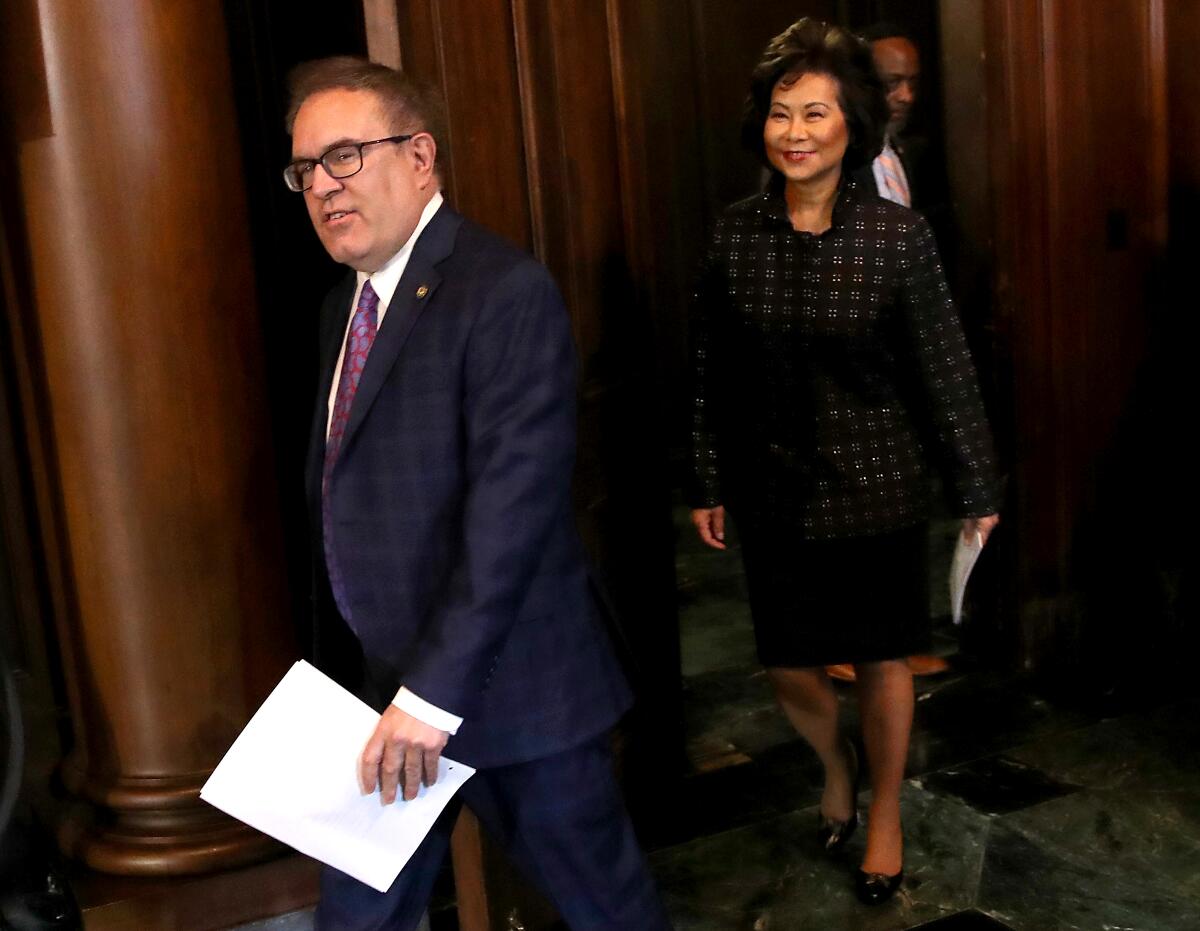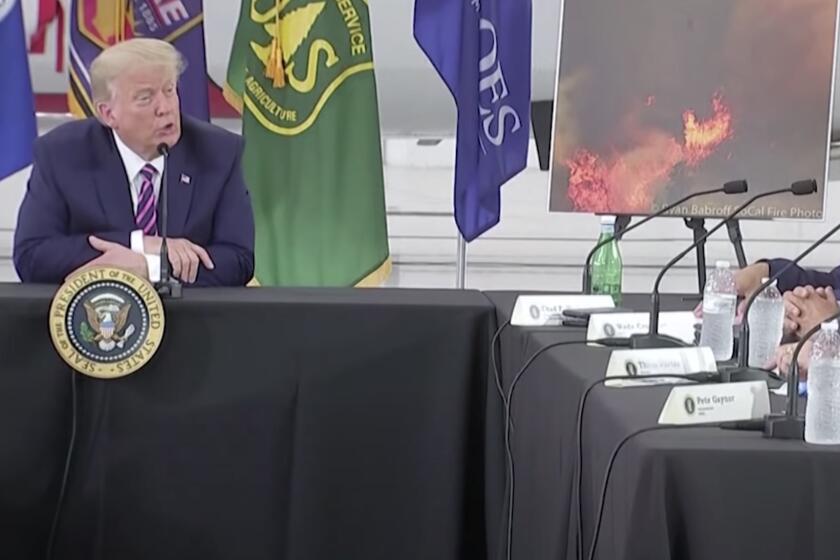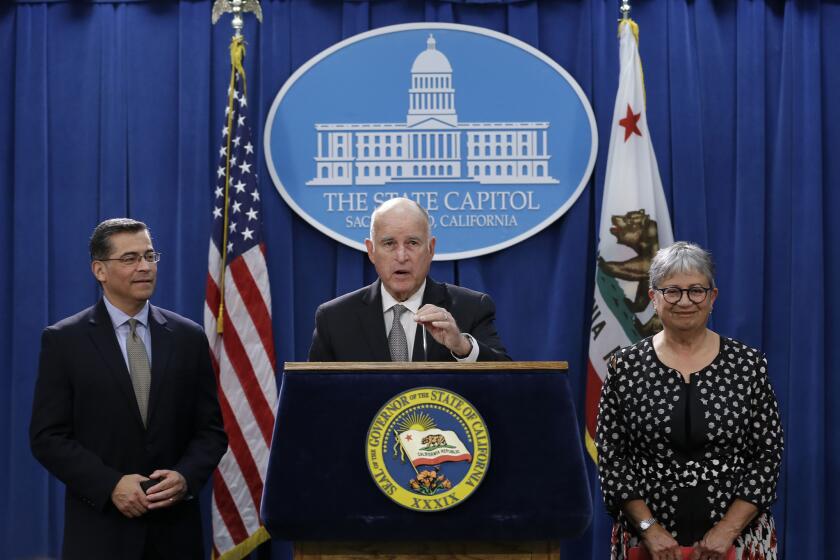Column: Biden can make historic strides on climate after four years of Trump vandalism

- Share via
“I’m just exhausted,” Jared Blumenfeld told me. “It’s been four years of just worrying about the next rule that’s going to help polluters and undermine public health. I’m just excited to not have to think about that anymore.”
As head of the California Environmental Protection Agency, Blumenfeld has been on the front lines of the effort to fight back against Trump administration attempts to roll back environmental laws and regulations.
The state participated in more than 60 lawsuits, often with coalitions of other blue states, to block those changes, most importantly to protect its authority to set its own auto emissions standards.
Joe Biden’s climate plan is certainly the strongest plan we’ve ever seen from a presidential candidate, never mind a president-elect.
— Gina McCarthy, chief executive of the Natural Resources Defense Council
The state also cut its own deal with six auto manufacturers to align the carmakers with California’s stringent standards.
The tide of contention between the state and the federal government is about to recede.
President-elect Joe Biden has signaled a shift in federal climate change and environmental policy that will reestablish science as the guiding force in the government’s approach after four years in which science was disdained by the federal Environmental Protection Agency and the Interior, Energy and Transportation departments.
Biden has said that on the first day of his administration the U.S. will rejoin the 2015 Paris climate agreement; President Trump’s withdrawal, which made the U.S. the only nation on the face of the planet to reject the accord setting goals for reduction of greenhouse gases, took formal effect Nov. 4, the day after the election.
Importantly, Biden has framed the battle against climate change in terms of economic and social justice. Government spending can fund millions of jobs rebuilding the nation’s infrastructure to accommodate an energy grid to support renewable power generation, according to Biden’s transition website.
That could include expanding charging stations for electric vehicles and building new transmission lines from wind and solar farms to population centers. Biden’s goal is a “pollution-free power sector” by 2035 while “righting wrongs in communities that bear the brunt of pollution.”
The warming trend afflicting California and the West is indisputable, except to those with minds shut tight. That’s President Trump in a nutshell.
Biden also has said that he views the fight against climate change as an “all-of-government” imperative involving not only agencies with environmental portfolios but also the whole spectrum of domestic and foreign policy government bodies.
“Joe Biden’s climate plan is certainly the strongest plan we’ve ever seen from a presidential candidate, never mind a president-elect,” says Gina McCarthy, who served as EPA administrator during the Obama administration and is now chief executive of the Natural Resources Defense Council.
“His talking about this as an opportunity to support millions of new jobs and to use clean energy to strengthen our economy and move it into the future is so helpful,” McCarthy says.
As is the case with other issues such as healthcare and immigration, Biden’s ability to undo the damage Trump has done to the causes of fighting climate change and preserving the environment will be constrained by a Republican Senate (assuming the GOP majority remains in place after the runoffs for two Georgia Senate seats Jan. 5).
But he’s not powerless. Rejoining the Paris accord can be accomplished by executive action. Biden can also resume enforcing environmental laws already on the books after four years of hands-off regulation.
“The Trump administration failed to execute any of the fines or accountability we would regularly see for violating the Clean Air Act or clean water rules,” says Christy Goldfuss, managing director of the Obama administration’s White House Council on Environmental Quality, who is now at the Center for American Progress. “From the very beginning, President-elect Biden and his team can exercise their enforcement authority to have a real impact.”
California’s emissions deal with five key automakers takes aim at Trump environmental rollbacks
Goldfuss adds that Biden has “a ton of authority to roll back decisions made in the Trump administration.” That’s especially so because “the shaky legal underpinnings of a lot of the Trump administration’s decisions make it much easier to reconsider them.”
Trump began or completed the process of rolling back 125 environmental rules and regulations, according to an analysis by the Washington Post. He strived to hollow out protections against pollution, eliminate constraints on logging and oil drilling in sensitive areas, and reduce efficiency standards for appliances and vehicles.
Most of those initiatives came under legal attack. The Trump administration lost 82 of 100 legal decisions related to rule making on energy, the environment and natural resources, calculates the Institute for Policy Integrity of New York University’s law school.
Often these adverse rulings were based on the lack of a suitable administrative record to support the rules — the result of laziness or incompetence at the agency level.
It wasn’t unusual for federal judges to conclude, as did District Court Judge George H. Wu of Los Angeles in a case involving the Trump-backed but environmentally dubious Cadiz water project in the Mojave Desert, that the administration “seemingly cherry-picks portions of different sources to craft a case for a directed/desired result.”
Such a slipshod approach may well be the undoing of one of Trump’s most aggressive attacks on climate change policy: his effort to roll back Obama-era auto emissions and mileage standards while revoking California’s long-held authority to establish its own vehicular emissions regulations.
MIT’s obituary of donor David H. Koch lauded him for donating to cancer research, but ignored a career undermining science.
The California waiver exempting it from federal rules placed the state in the forefront of national initiatives aimed at reducing greenhouse gases. As we’ve reported, 13 other states accepted California’s standards as their own, accounting all told for nearly 40% of the U.S. auto market. That made the California rules a de facto national standard.
Nevertheless, the Trump administration bulled ahead with its attempt to roll back the standards, which were established under Obama and called for average vehicular fuel efficiency to rise to 54.5 miles per gallon between model years 2017 and 2025. The Trump administration plan was to freeze the auto mileage standard at the 2020 level, only 36.9 mpg.
The Trump plan was half-baked from the start, its supposed scientific foundations debunked by 11 experts at leading universities, including UC San Diego, Davis and Berkeley; USC, Yale and MIT. The weakness of the administrative rationale spurred lawsuits filed by 22 states, the District of Columbia, the cities of New York and Los Angeles and several environmental groups.
Those cases, which also seek to invalidate the revocation of the California waiver, are still pending in court. California, meanwhile, cut its own deal with Ford, Honda, BMW of North America (which also represents Rolls-Royce), Volkswagen Group of America (which owns Audi) and Volvo, which account for 30% of U.S. auto and light truck sales.
The agreement gives those automakers modest relief from the state regulations — imposing a standard of about 50 miles per gallon by 2026 — but remains far more stringent that the Trump rollback.
General Motors, Fiat Chrysler and Toyota, along with several other foreign carmakers, chose to throw in their lot with Trump, taking the administration’s side in the litigation. This looks like a bad call, since with Biden’s ascent to the White House it’s likely that the government will move to reestablish the Obama standards and the California waiver, rendering the legal battle moot.
The holdout companies are beginning to show some awareness that they hitched their wagons to the wrong star, Blumenfeld says.
California’s climate deal with automakers shows the proper solution to Trump is to go around him.
Even before election day, he says, “we were getting some signals from some of the auto folks that they were starting to hedge their bets and were wanting to cooperate more with us than they were six months ago.”
He wouldn’t identify which automakers had begun to reach out. But he said that California’s message to them was that “either legally or financially, you’re going to be on the losing side of history” by continuing to press for a rollback of standards.
The holdout automakers haven’t said for the record that they’re willing to abandon their quest to roll back the Obama-era rules.
“We’re committed to working with all key stakeholders — including federal and state policymakers, labor, environmental groups, auto suppliers and dealers,” John Bozzella, CEO of the Alliance for Automotive Innovation, a lobbying group representing the holdouts, said in an emailed statement. “We will continue to be part of the conversation.”
Even where Biden has the authority to take unilateral action on climate change, practicalities stand in the way. Experienced professional staff have fled or been driven out of the EPA and the departments of Energy and the Interior. With many if not most of them lost to federal service forever, rebuilding won’t be quick or easy.
“The Trump agenda has been basically a blitzkrieg when it comes to these agencies that protect public health and the environment,” Blumenfeld says.
Trump has also been rushing rule changes into effect before he leaves office, complicating any effort to undo them.
In late October, the administration issued a final decision opening up more than half of Alaska’s vast Tongass National Forest to logging and other development, threatening the habitats of wild salmon, deer and brown bears as well as stands of timber that hamper climate change by absorbing carbon from the environment.
Trump’s Interior Department is also rushing to lease lands in Alaska’s Arctic National Wildlife Refuge to oil drillers before he leaves office. Biden, who has promised to protect the refuge from development, could halt that process unless leases are already issued, which experts say could happen in the weeks before Biden is inaugurated.
It’s unclear how eager drillers will be to bid on the leases, given the expense of mounting operations in the remote refuge and the likelihood that those activities will be politically controversial. That raises questions about why Trump is so intent on ramming the leasing through in the final weeks of his term.
“Most people would agree that efforts to open up the Arctic to drilling at this point,” McCarthy says, “are just gratuitous slaps in the face, frankly.”
More to Read
Inside the business of entertainment
The Wide Shot brings you news, analysis and insights on everything from streaming wars to production — and what it all means for the future.
You may occasionally receive promotional content from the Los Angeles Times.















